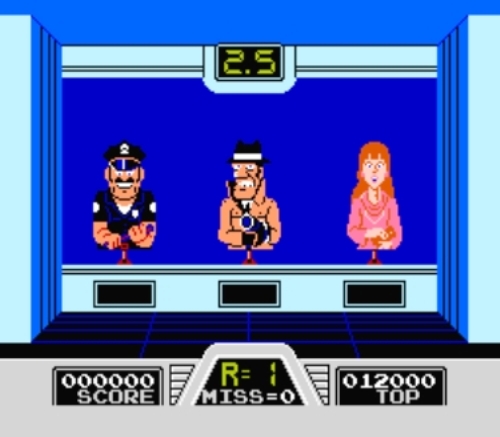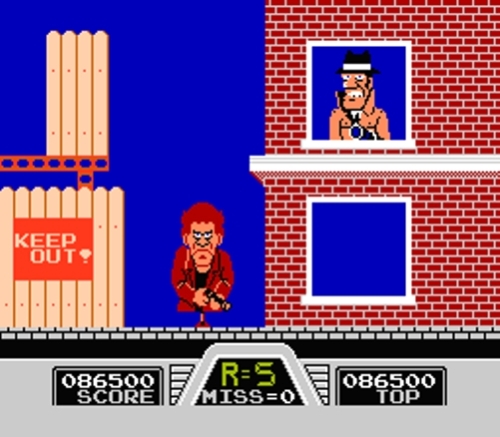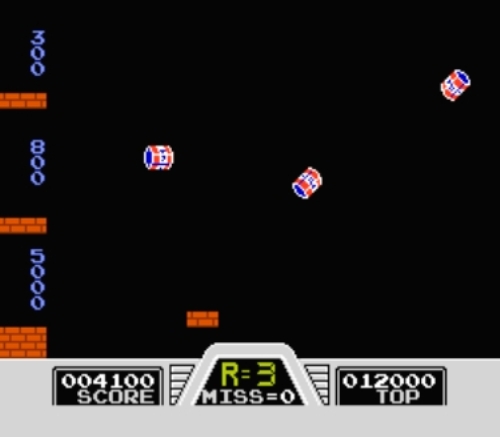Hogan's Alley Review Rewind
|
|
See PixlBit's Review Policies

On 11/06/2015 at 12:00 AM by Jamie Alston Training Day |

A good choice for anyone looking for a light gun Zapper game that's fun in short bursts.
I knew very little about Hogan’s Alley back in its heyday. Judging by the mean-looking gangster fully armed with a gun and grimace on the front cover, I figured that the game must have been some 3D action title featuring all sorts of wanton violence that my impressionable mind just couldn’t handle. However, as the years passed I eventually learned the facts of this game’s less menacing purpose.
Originally released in 1984 in Japanese arcades, Hogan’s Alley was a simple target practice game somewhat modeled after the real-life Camp Perry National Guard training facility of the same name. The game featured no serious allusions to heavy violence. Instead, it only had what were essentially cardboard cut-outs of targets to test your shooting skills. A year later, Nintendo made it a launch title for the US release of their NES console. This game taught me a lot about myself. Apparently, I'm a trigger-happy loose cannon that will open fire on just about anything.
I never thought that a game could force me to call into question my ability to identify and shoot a few targets. Hogan's Alley forces you to hone both your marksmanship and quick judgement skills. You are placed in a training facility that houses cardboard cutouts of six individuals. Three of the six are the targets you want to shoot-- Gangster A, Gangster B, and (surprise!) Gangster C. The other three characters are the innocent civilians that you'd do well not to shoot-- the Lady, Professor, and Policeman. Shooting a civilian or failing to shoot the gangster(s) onscreen counts as a "miss" against you. Get 10 misses, and it's game over you.

In the same vein as other early NES light gun games, Hogan's Alley is made of three parts-- Game A, B, and C. Game A is a simple shooting range where each round consist of a mixed lineup of 3 characters. Your goal is to quickly identify and shoot the gangsters in the lineup. Naturally, there will be civilians in the lineup as well, so care must be taken not to shoot them. The numeric figure above the characters represents how many seconds you have to hit to correct targets. This is where much of the challenge is presented.
At first, you're allowed 2.5 seconds to hit your targets. But soon, the game starts getting tricky by giving you only 0.6 seconds to shoot two gangsters. Short time constraints always makes me nervous and I end up hitting only one of two targets, or worst yet, shooting a bystander. The other major challenge factor is trying not confuse a civilian for one of the bad guys. This is especially so with the Professor and Policeman. They wear the same color of clothing as Gangster A and C. On a good day, I can make it to round 48 before I have to do the walk of shame.

Game B is more involved than the former one. In this mode, you have to deal with both stationary, and moving targets. The same rules apply though. Here, you are placed in an urban scenario where gangsters and civilians move between buildings, windows, and streets. Each round consist of five scenes where both quick wits and an itchy trigger finger are required to succeed. I tend to prefer the Game B mode because it become even more challenging than picking through a lineup. Again too, it is all too easy to accidentally shoot a civilian, so you have to be extra careful. If there’s one complaint I have about both game modes, it's that it sometime feels like the light gun doesn't react as fast as the game demands when I'm trying to quickly shoot two targets.
The final game mode, Trick Shot, is mostly just a bonus game mode. In this mode, cans are tossed on-screen and you have to get them to land on one of the platforms on the opposite side by shooting them in order to keep them suspended in the air long enough. You are awarded points according to which platform the cans land on-- the highest platform awarding the least points, and the bottom platform yielding the most points since it it takes a skilled shot to land them there safely without missing. As with the other two game modes, you are allowed up to 10 missed before the game is over. While it doesn't amount to much in the form of excitement, it's still a nice diversion in the event that your brain gets tired of the shoot/don't shoot exercises from the other other two modes.

The graphics aren't as impressive as the many other games that would come after it. Everything is very simplistic looking and standard fare. However, compared to games like Duck Hunt, Hogan's Alley does have a bit more going for it. It can best seen in Game B, where the the scenery changes enough to at least keep things interesting. Every two rounds, the color palette also changes to keep thing from feeling too repetitive in a short period of time. Of course, that only goes but so far these days, but it was nice to see the development team attempt to create some for diversity with the scenery this time.
There isn't much going on with the audio presentation in the way of music. Like other early NES games, you get a quick ditty that plays at the title screen, as well as a few notes that play every so often when advancing to another round. It's really not a problem though because the lack of music helped me to keep my concentration. In contrast, sound effects play a bigger role, especially in Game B, because you have to listen out for moving targets and enemies that suddenly pop out from the shadows. It works to great effect because you won't be conflicted between listening out for movement and hearing some quirky song playing in the background.
While better target shooting games have been created since the release of this one, Hogan's Alley is still a worthy entry in the NES light gun series. Underneath its simplicity perfectly lies gameplay elements that would likely still challenge even the most seasoned of gamers out there. If Duck Hunt was a little too easy for you, then Hogan's Alley might be a better fit instead.









